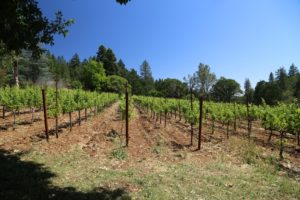
 Selah Wines was founded by Joe & LeeAndra Blanton with their inaugural 2014 vintage. Ultimately the game of baseball is responsible for Joe’s interest in wine. 2005 was Joe’s first year playing Major League Baseball, conveniently pitching for the Oakland Athletics. As one of the younger players on the team, several of the veteran ball players would invite him out to dinner either on off days or following daytime baseball games. Joe was in his early 20s at the time and as a result of these dinners was exposed to fine dining and a variety of wines.
Selah Wines was founded by Joe & LeeAndra Blanton with their inaugural 2014 vintage. Ultimately the game of baseball is responsible for Joe’s interest in wine. 2005 was Joe’s first year playing Major League Baseball, conveniently pitching for the Oakland Athletics. As one of the younger players on the team, several of the veteran ball players would invite him out to dinner either on off days or following daytime baseball games. Joe was in his early 20s at the time and as a result of these dinners was exposed to fine dining and a variety of wines.
During his time playing for the Athletics, he found himself becoming more interested in wine and gravitating towards the Napa Valley, when in town often taking day trips up to the valley to explore the diversity of wineries. During one of these trips, he visited Outpost Winery and befriended one of their employees who eventually introduced him to winemaker Thomas Brown.
While visiting wineries in the valley, Joe gravitated towards the smaller producers – enjoying being able to meet with the owners and winemakers. When he decided to begin searching for land in the valley, he enlisted the help of a local realtor to search for smaller vineyard sites. While visiting Outpost during one of his trips he casually inquired about a 7-acre piece of property about a 5-minute drive from Outpost. Hearing good things about this particular site, Joe and LeeAndra purchased the property in 2014.
Their focus is on a single wine each year, a 100% varietal Cabernet Sauvignon from a tiny 2.75-acre vineyard located at approximately 1,700 feet on Howell Mountain. The site is planted entirely to two clones of Cabernet Sauvignon, Clone 7 and 337 and is bordered by one of Beringer’s premier vineyards, the Steinhauer Ranch.
Prior to the Blanton’s ownership grapes were being used for a small brand called Blue Hall. Blue Hall was owned by two medical doctors, Andrew Zolopa & Annie Talbot. Andrew devoted his medical career to caring for those with HIV and AIDS and was instrumental in starting the HIV program at Stanford University in 1994. For 20 years, Andrew has taught at the Stanford School of Medicine; he is currently a professor of medicine (infectious diseases).
The name ‘Blue Hall’ came from the Silverado Squatters, written by Robert Louis Stevenson – a book everyone should read with an interest in historical Napa Valley. Mr. Stevenson was on his honeymoon in Napa Valley when he and his wife ran out of money – not necessarily a common occurrence on honeymoons today. Not wanting to cut his honeymoon short he and his wife found out about some quick silver mines on the flanks of Mt. St. Helena in the northern part of the valley. Setting up for the rest of their honeymoon they ended up living in a cabin on the edge of the mountain (the cabin site is still there surrounded by oak trees). Looking up at the blue sky he felt he had entered ‘the blue hall of heaven’.
Andrew purchased this property in 1998; it was not planted to grapes at that time and he had no intent of planting a vineyard. One day his real estate agent asked the question that is often asked in Napa when one owns land that is not yet planted to grapes, but is surrounded by vineyards, “when are you going to put in a vineyard”. Only two years after he purchased the property, Pina Vineyard Management planted the first vines on the property. The first commercial release from this vineyard (bottled as Blue Hall) was the 2005 vintage, although the 2004 vintage was later released as a library wine. Like Selah, Blue Hall produced a single wine from the property.
Despite its diminutive size, the vineyard contains two blocks, an upper and lower section. And one side of the vineyard will always be native vegetation as it borders the Napa Land Trust, a non-profit organization that acquires and preserves property in Napa Valley.
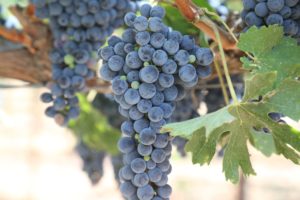
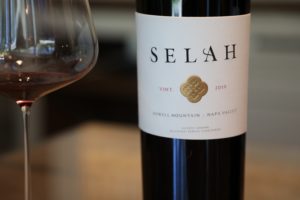 Looking to produce wine in 2014, Joe and LeeAndra tasted a number of wines blind from various winemakers in the valley and arrived at one conclusion; they enjoyed the style of wines from Thomas Brown. He accepted their offer to be their winemaker and soon introduced them to Josh Clark who now manages their vineyard. Each clone is harvested, fermented and aged separately until the final blend is created.
Looking to produce wine in 2014, Joe and LeeAndra tasted a number of wines blind from various winemakers in the valley and arrived at one conclusion; they enjoyed the style of wines from Thomas Brown. He accepted their offer to be their winemaker and soon introduced them to Josh Clark who now manages their vineyard. Each clone is harvested, fermented and aged separately until the final blend is created.
Thomas Brown is one of the busiest wine makers in Napa Valley. Several producers have showed us lists of all the Napa brands that he consults for and or provides direct winemaking services; this is an extensive list. He is from South Carolina and developed an interest in wine while attending the University of Virginia where his major was not wine related (he studied English and Economics).
He moved to Napa Valley in 1996 and took a job at All Seasons Bistro in Calistoga which was known for their California cuisine, wine selection and two decades in business, but permanently closed in 2020. While there, Thomas met winemaker Ehren Jordan who was working for Larry Turley at the time of Turley Wine Cellars. Thomas took a job with Ehren in the cellar at Turley in 1997; he spent several years there before beginning his own career and starting to consult for various clients including some that Ehren was already working with.
And within only 10 years of making wine in Napa Valley Thomas received two 100-point scores from Robert Parker; regardless of what your perception is of scores, creating several wines within a short period of time that receive 100 points from Parker was a watershed moment in Thomas’s consulting career.
Today Thomas is highly sought after for his winemaking services, experience and access to premium area vineyards. And while he was once the student, over the years he has become the teacher. We have met with a number of winemakers who worked under Thomas – and consider him one of their mentors. These are winemakers who have gone on to establish their own brands or consult for other Napa based brands.
Select Wines
Chardonnay
The 2023 Selah Chardonnay Russian River Valley is medium to deep gold in color; the aromatics need some time to be teased out, but when they start showing they feature aromas of apricot, yellow nectarine, golden delicious apples, honeysuckle, caramel, butterscotch, vanilla and a kiss of hazelnut. Superbly balanced from entry through the finish, the palate delivers flavors of apricot, pineapple and papaya. This wine finishes, bright, alive, refreshing, and with a persistent flavor filled finish. Unlike a number of California Chardonnays, which tend to be a meal in and of themselves, this wine is very much a food friendly expression of the variety. They don’t make much of this beauty; it’s the inaugural release and will sell out quickly.
Cabernet Sauvignon
The 2019 Selah Cabernet Sauvignon is deep ruby and opaque in the glass; the bouquet is immediately expressive, showcasing its fruit core of spicy plum, cherry, boysenberry, dark raspberry, along with cocoa powder. One can almost smell the soils; tasting this wine brings us back to times we’ve spent at the Selah Vineyard, surrounded by its noticeably red soils and pine trees. The palate is lively, yet also showcases the ‘Selah balance’ with flavors of dark raspberry, plum, cherry, and blackberry. This bottling shows a bit more depth in terms of both flavor and texture than the previous vintage. Lingers dusty, with gravelly textured, but rounded tannins with a note of dried tobacco leaf, assorted dried herbs, and a dusty/earthy character. Its texture continues to show for quite some time on the extended finish and eventually outpaces the fruit. Features a balanced acidity. This wine has loads of life ahead of it and should definitely be on the list of any collector of the Selah wines.
The 2018 Selah Cabernet Sauvignon is deep ruby and opaque; the aromas are layered and darker fruited including scents of blackberry, boysenberry, dark chocolate and old cedar box, with a lingering note of cocoa. And there is a light more gamey note deeper in the aromas as it evolves. This wine is showing in a sweet spot right now in terms of texture, balance, flavor profile and acidity. The cocoa powdered tannins are tumbled, rounded and sport a cushiony texture and they linger with a dusty character and a light note of dried tobacco leaf. On the palate there are flavors of dark raspberry, blackberry, dark cherry, boysenberry. Joe noticed this wine has carried its aromatic and palate character consistently since it was released. It was an approachable wine right out of the gate. And it still is. In terms of pairing, this would be an ideal companion with a dry rub wagyu tenderloin.
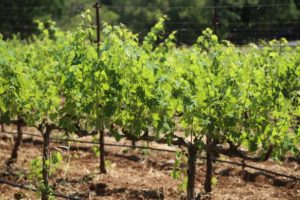
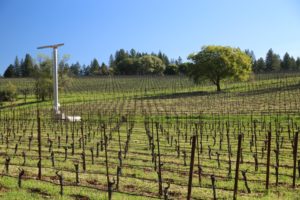
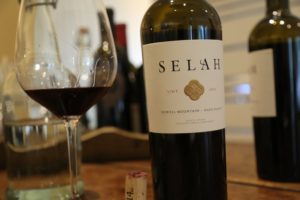 The 2014 Selah Cabernet Sauvignon offers a compelling diversity of aromas; on the bouquet, the fruit transitions to dessert spices as the wine opens revealing notes of cinnamon along with hints of old cedar box. The texture is harmonious from start to finish and features a textural softness which makes this wine highly approachable in its youth. In general, this approachability and texture feel is similar to a number of 2014 wines we have tried from Napa Valley but is also indicative of this particular site. The palate sports ripe flavors of boysenberry and blackberry. The finish is mouthwatering with slightly chalky and finely integrated tannins. There is plenty of intensity on the palate without any accompanying big mountain tannins.
The 2014 Selah Cabernet Sauvignon offers a compelling diversity of aromas; on the bouquet, the fruit transitions to dessert spices as the wine opens revealing notes of cinnamon along with hints of old cedar box. The texture is harmonious from start to finish and features a textural softness which makes this wine highly approachable in its youth. In general, this approachability and texture feel is similar to a number of 2014 wines we have tried from Napa Valley but is also indicative of this particular site. The palate sports ripe flavors of boysenberry and blackberry. The finish is mouthwatering with slightly chalky and finely integrated tannins. There is plenty of intensity on the palate without any accompanying big mountain tannins.
The 2015 Selah Cabernet Sauvignon is deep purple in the glass, even darker then the 2014 vintage. Somewhat brooding on the bouquet, the aromas are deep and dark – offering ripe plum, blackberry, boysenberry, earth notes, cedar, a sweetness of fruit and hint of tobacco. But the bouquet is mostly about the fruit. On the palate shows ripe plum and blackberry and a finish that continues to give, offering both gravelly tannins and flavor. This is a mor robust showing than the 2014.
There is a consistency in the Selah wines in terms of both viticulture and winemaking, with the difference from year to year showcasing vintage variation. Regardless of the year, however, for some reason the even years tend to be the more approachable, immediate crowd pleaser wines, while the odd years are more layered and take some time to evolve. Due to immediate fires in Napa Valley during the 2020 vintage, no wine was produced that year.
With demand from customers to have a white wine, especially when Selah pours their estate Cabernet Sauvignon at events, plans are in place to produce a companion white wine, a Chardonnay from neighboring Sonoma County. Its inaugural vintage will be from 2023.
—
The name Selah was carefully chosen as the name of their brand. LeeAndra spotted this word one day and loved its sound; it is a Hebrew word that means “to pause or to reflect”, an appropriate description when referring to enjoyment of wines but even more appropriate as it relates to their own story in Napa Valley. After the end of every season teammates would often ask Joe where he was going or as he puts it, they would inquire about his “reset or pause button”. For Joe and LeeAndra the reset button was Napa Valley. Every November he and LeeAndra would spend several weeks relaxing in the northern part of the valley.
Since then, Napa has become more than an escape destination for the Blantons; they were engaged in Calistoga and then married in the valley. And today they also live and work in Napa Valley. One piece of advice rang true for Joe, if you are going to start a brand, be as involved as you can be. He helps during harvest, markets the wines including attending select vintner dinners, a very limited number of consumer tastings and related wine events around the country.
And Joe’s friend Rich Smock has been an important part of helping to market the Selah Wines in select places nationally. Rich initially met Joe in 2010 on Howell Mountain; Rich’s friend used to host tastings at Robert Foley Winery. He called Rich up one day and said, “you are from Philadelphia, right?, I have one of the Philly players coming to do a tasting at Outpost Winery”. Rich remembers entering a completely darkened cave at Robert Foley and yelling out for the group; they finally answered but no lights came on and they all stumbled around until they located each other. Rich then invited the players up to Outpost Winery for more wine tasting.
Joe reached out to Rich in 2013 and told him a vineyard on Howell Mountain was for sale. Rich replied that he knew the vineyard from often driving by it on his way to Outpost Winery. He noticed that one section of the site was prone to frost. And he offered to have others in the business take a closer look at it including viticulturist Josh Clark. Once Josh walked the vineyard, he recommended that once a frost fan was installed and the farming was dialed in, the vineyard would be an A+. He was not wrong.
Joe’s original intent was to sell the grapes; he was still playing at the time and wasn’t sure how long his career would last. Rich and Thomas both encouraged Joe to start his own brand, rather than sell the grapes. This story is about being in the right place at the right time. And Thomas certainly appreciates Joe’s level of commitment to sports – tied into his own perspective of excelling at both baseball and soccer in high school.
And then in 2023, Rich reached out to Joe again after returning from an epic year long RV trip through 25 states in the U.S. Tying in Joe’s baseball connections has worked favorably in marketing the wines including at Philadelphia Phillies fantasy camps and alumni get togethers. The Selah wines are the only red wine at the Executive Dining Room at Citizens Bank Park in Philadelphia, a 2,000 square foot space used to host private events.
And Rich and Joe participate in various charitable gatherings including for the Darren Daulton Foundation and the Tug McGraw Foundation.
—
Production is tiny and has ranged from between 200 to approximately 300 cases per year. Drought and vine age has played a role in these varying production numbers. As of our latest update to this review, the wines are primarily available via the website or sometimes through ACME Fine Wines located in St. Helena, Wine Country Connection in Yountville or Backroom Wines in the city of Napa. And through a limited number of distribution in Kentucky, New York and New Jersey and Alabama.
For more information or to purchase wine, visit: www.selahwines.com






Hello Mr Blanton ; I’m from Toronto Canada . July 4 th I saw you and your family at the As game sitting directly opposite to you . I thought you looked familiar but didn’t realize until later who you were . I congratulate you on your wonderful career and your World Series ring ( game 4 winner and a home run ) . Although this as nothing to do with your winery it’s nice to see you found a second career with your wonderful family. It’s good to see . !!!
Mark – I hope you connected with Joe directly. His vineyard is producing exceptional wines.